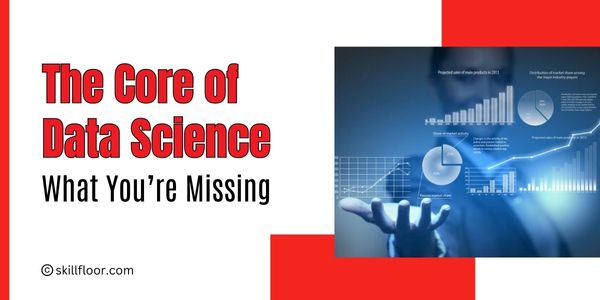What are the Core Principles of Data Science?
The power of data science with core principles like data cleaning, predictive analytics, and model building. Don’t miss out on insights that drive success.

Every day, more than 2.5 quintillion bytes of data are generated, a staggering number that highlights the importance of data science to understanding it all. Having worked as a data scientist for almost 5 years, I have seen firsthand how fundamental ideas transform raw data into useful insights. At first, the complexity of the tools, algorithms, and datasets was overwhelming. However, I quickly learned that focusing on fundamental ideas—such as exploratory analysis, statistical modelling, and data cleaning—provides a great deal of clarity. Studies show that data scientists spend 80% of their time on these tasks.
For example, Predictive analytics, which drives industries like healthcare and finance, depends on understanding data distribution and using models such as regression or classification. Dashboards and other visualization tools make communication easier because 90% of people understand images more easily than text. In today's data-driven world, mastering these principles helps us turn overwhelming information into meaningful facts by allowing us to identify trends, predict results, and drive decisions.
What is Data Science?
To extract, process, and analyze data for useful information, data science is a multidisciplinary field that includes computer science, statistics, mathematics, and domain-specific expertise. It involves collecting raw data from various sources, organizing and cleaning it to ensure quality, and using analytical methods to find trends, patterns, and connections. Data science turns both structured and unstructured data into information that can be put to use by using advanced algorithms, machine learning, and visualization tools. As the basis of today's data-driven world, it enables businesses to make the best decisions possible, predict results, and drive innovation in a variety of fields.
Core Principles of Data Science
To find valuable insights and make data-driven decisions, the multidisciplinary area of data science combines statistical analysis, computer methods, and domain experience. The fundamental ideas of data science are the foundations for practitioners to ensure precision, effectiveness, and ethical conduct in their work. A complete overview of these ideas may be found below:

Data Collection and Acquisition
As the quantity and quality of data are important to any project's success, data science begins with the collection of relevant information.
-
Sources of Data: Data sources include open data repositories, social media, IoT sensors, databases, APIs, site scraping, and surveys.
-
Challenges: It includes unstructured data (such as text or photos), inconsistent formats, and ethical considerations like authorization and data consent.
-
Tools Used: Python libraries (such as BeautifulSoup and requests), SQL for databases, and data ingestion platforms like AWS Data Pipeline and Apache Kafka.
Data Cleaning and Preprocessing
Raw data is rarely ready for data analysis. Data consistency, completeness, and integrity are ensured by preprocessing.
-
Tasks: Using imputation (mean, median, mode) or elimination to deal with missing variables.
Removing outliers and duplicates that may cloud the results.
Data should be normalized or standardized to ensure comparability.
Encoding categorical variables (e.g., one-hot encoding).
-
Challenges: The difficulties lie in finding a balance between enhancing data quality and avoiding bias or losing important information.
-
Tools Used: Python (pandas, numpy), R, and ETL (Extract, Transform, Load) tools such as Informatica or Talend were used.
Exploratory Data Analysis (EDA)
EDA shows relationships or irregularities that help in understanding the structure of the dataset.
-
Key Steps:
An overview of the statistics measures such as variance, standard deviation, mean, and median.
Visualization To show patterns and relationships, use heatmaps, box plots, scatter plots, and histograms.
Identifying possible outliers, clusters, or relationships.
-
Challenges: Preventing erroneous correlations or patterns from being misinterpreted.
-
Tools Used: R (ggplot2), Tableau, and Python (matplotlib, seaborn, plotly).
Feature Engineering
Improves model performance by adding, choosing, or altering variables in the dataset.
-
Key Techniques:
Combining variables (e.g., total income = price × quantity) is the process of creating features.
Dimensionality reduction: Methods to cut down on duplicate characteristics, such as Principal Component Analysis (PCA).
Handling temporal data: creating rolling averages or lag characteristics from time-series data.
Features for algorithms that are sensitive to the size of the data are scaled and normalized.
-
Challenges: Enhancing model efficacy while preserving interpretability.
-
Tools: R and Python (sklearn, feature-engine) were the tools used.
Model Building and Training
Constructing predictive models with historical data to make decisions or options.
-
Key Steps:
-
Data split into training, validation, and testing sets is a crucial step.
-
Choosing suitable algorithms (such as neural networks, decision trees, and regression).
-
Hyperparameter tuning through the use of methods such as random or grid search.
-
Challenges: Problems include underfitting (the model does not capture complexity) and overfitting (the model does well on training data but badly on new data).
-
Tools: R, cloud platforms such as AWS SageMaker or Google AI, and Python (scikit-learn, tensorflow, and keras).
Model Evaluation and Validation
Evaluating the model's ability to ensure accuracy and reliability.
-
Metrics Used:
Mean Absolute Error (MAE) and Root Mean Square Error (RMSE) are used in regression.
Classification parameters include F1-score, AUC-ROC curve, accuracy, precision, and recall.
Validation methods include cross-validation (such as k-fold) to evaluate the generalizability of the model.
evaluating in contrast to a separate dataset.
-
Challenges: Providing fair evaluation is a challenge, particularly when dealing with imbalanced data sets.
-
Tools Used: R, Python (sklearn), and performance metrics visualization tools.
Key Benefits of Data Science
Data-Driven Decision Making
-
According to a Shiksha survey, more than 90% of business leaders think data science is important for making decisions.
-
According to McKinsey, businesses that use data analytics reach productivity gains of 5–6% on average.
Enhanced Automation and Efficiency
-
According to PwC, data science-driven automation could save companies up to $2 trillion a year by 2025.
-
Within two years, almost 80% of companies that use AI report increased operational efficiency.
Personalization and Improved Customer Experience
-
Data science-driven personalised marketing can increase conversion rates by 20%.
-
According to McKinsey, 71% of customers believe individualized gets and 76% become frustrated when they don't get them.
Predictive Insights for Future Planning
-
According to MarketsandMarkets, the market for predictive analytics is expected to reach $22.1 billion by 2026, with an annual growth rate of 23.2%.
-
According to Forbes, companies that use predictive analytics report a 30% increase in predicting accuracy.
Fraud Detection and Risk Management
-
Up to 95% of fraudulent activity can be detected in real time by data-driven fraud detection systems.
-
Given its growing significance, the global market for AI in risk management is expected to reach $38 billion by 2030.

Applications of Data Science
Business and Finance: Demand forecasting, fraud detection, customer segmentation, and marketing strategy optimization are all made possible by data science. Data science is used by financial institutions for portfolio optimization, credit rating, and risk management.
Healthcare: Data science helps patient outcome analysis, drug discovery, personalized therapy, and illness prediction in the healthcare industry. It helps to lower expenses, improve patient care quality, and optimize healthcare operations.
Retail: Data science is used by retailers for pricing optimization, inventory control, customer retention, and recommendation systems. Customer behaviour analysis helps in customizing marketing strategies for maximum impact.
Education: By using predictive modelling to identify at-risk learners, student performance analysis, and adaptive learning platforms, data science improves educational systems. To enhance learning outcomes, it helps institutions in making data-driven decisions.
Transportation and Logistics: Three major uses of data science in the transportation and logistics sector are supply chain route optimization, vehicle predictive maintenance, and traffic flow analysis. It helps to increase overall efficiency and reduce expenses.
Challenges in Data Science
1. Data Quality Issues
Inaccurate insights may result from poor data quality. Reliable analysis must address inconsistencies, duplication, and missing values.
2. Model Interpretability
Deep learning and other complex models are frequently criticized for being "black boxes." Gaining the trust of stakeholders requires ensuring interpretability.
3. Ethical Dilemmas
It's rarely easy to find a balance between innovation and morality. Data misuse might result in skewed results and privacy violations.
4. Rapidly Evolving Tools
Data scientists must keep up with the latest tools, algorithms, and best practices because the field is changing quickly.
The principles of data science offer a strong basis for solving complex issues and arriving at well-informed conclusions. Data scientists may use data to drive significant change by stressing ethics, scalability, curiosity, and clear communication. Knowing these concepts will enable you to navigate with confidence the data-driven world, whether you're looking for new employment prospects or ways to use data in your company.
Remember that data science is about asking the appropriate questions, using the proper tools, and coming to meaningful conclusions—it's not just about the statistics. Therefore, bear these ideas in mind as you start your data science journey and allow them to direct your course to success.




























































